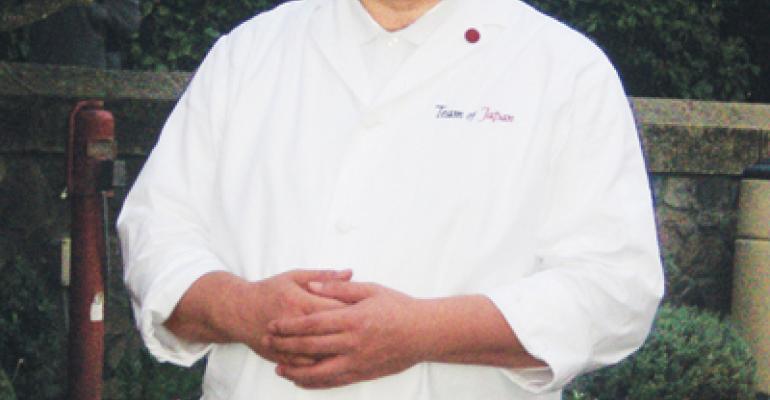Kunio Tokuoka is the third-generation chef-owner of Kyôto Kitcho, a restaurant in Kyoto specializing in kaiseki, a tasting-menu style of very high-end fine dining that focuses on using excellent, seasonal ingredients. He now also operates two other restaurants in Japan and a fourth restaurant in Singapore. During the recent Worlds of Flavor conference at The Culinary Institute of America, he sat down with Nation's Restaurant News and shared his observations about customer service and the proper pacing of a fine-dining meal.
Is there a particular structure to a kaiseki meal?
Our first course is intended to spark the diners’ curiosity and stimulate their appetite. Next we serve a simple soup, which is intended to gauge the customer’s taste. If it’s too salty, for example, we keep that in mind for the rest of the meal, and of course we continue to adjust the meal based on their taste. I adjust portion sizes, and of course I ask if there’s anything they don’t eat. And obviously if we see something they don’t like, we change it.
Right, but are customers always honest with their answers? Aren’t they likely just to be polite and tell you that the food’s good?
It’s not about their saying whether the food is good or not. We want to strike their emotions. We want to bring tears to their eyes. You can’t fake that. Of course it’s also a good sign if they talk about the food.
Next is fresh fish, to show our very freshest ingredients. Sometimes its raw, sometimes its seared or broiled on the outside. Sometimes we serve four different kinds of fish separately, sometimes they’re all served together. We also change the beverage pairing. Sometimes we serve sake, but if they prefer to drink wine then we served cooked fish, or we cook something dramatic in front of them, like abalone on a hot stone with an abalone liver dipping sauce.
Then we give the customers a break with something small and simple, such as a chawan mushi [egg-and-seafood custard].
Then we do something with strong visual impact that expresses the season. That’s the hasun, which in a traditional tea ceremony is an offering to a god.
On the plate will be something from the mountain and the sea, and that combination represents the entire universe.
Up to that point in a tea ceremony, the host doesn’t talk, but just serves the guest. After the hasun is served, the host brings the sake and the guest and the host eat together from then on. That’s when the conversation starts. It’s a dish that’s supposed to be both stimulating and relaxing.
When the hasun is served, sometimes we change the lighting in the room. We might turn them down and set the table with lanterns made from daikon with candles in them.
If it’s a couple that’s dining, we might just keep the lights low to make for a more romantic evening. It depends on what the server thinks the customers would prefer.
Next comes broiled meat, then cooked vegetables, a marinated course, and finally rice, followed by fruit and sweets.
Besides the food and the lighting, are there other things you do to make the dining experience special?
I went to see a psychology professor from Kyoto University to see what was the most important thing we could do to move our customers emotionally.
He said there must be a gap between reality and their experience in the restaurant. It’s like when you see a movie and follow the actions of the hero. That helps you forget the stress in your own life by taking you somewhere else.
We try to do the same thing with the dining experience — to make it very different from their normal lives, and we try a lot of different things to do that.
The servers talk to the guests slowly and very politely. That helps them slow down their pace, and to make time appear to move more slowly, unlike daily life which is so high-speed.
The first year we tried this approach, three customers cried.
We are also very careful about our phrasing. We use words that stimulate the customers’ imaginations. Whenever we communicate with them, we want them to feel like it’s an extraordinary experience.
Contact Bret Thorn at [email protected].

